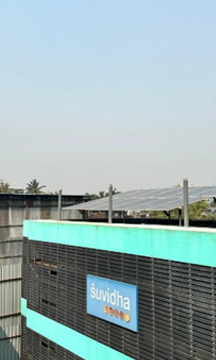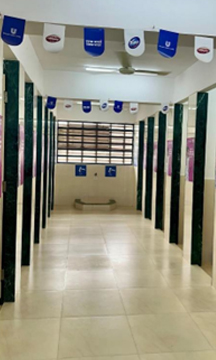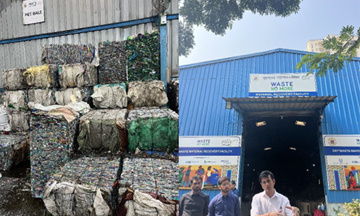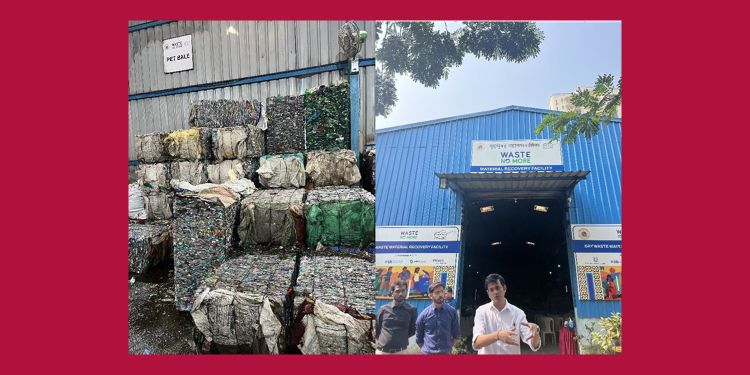Professor Vikram Gandhi’s Immersive Field Course (IFC) “Development while Decarbonizing: India’s Path to Net-Zero" delved into the critical aspect of decarbonization and sustainability goals amid India's rapid development. The course presented an opportunity for students to advance their knowledge of sustainability efforts, decarbonization, and net zero in the context of a broader development agenda. The class culminated in a series of site visits in January 2025 in Mumbai and Bangalore and this is one of 9 student essays that highlights their reflections on uncovering sustainable solutions across the country.
Introduction and Context
Our time in India exposed the severe risks vulnerable populations face due to climate change, while showcasing the resilience of local communities working to address these challenges. During our visit to Mumbai, we explored two impactful sites as part of our visit to Hindustan Unilever (HUL), a subsidiary of Unilever.
We visited a community sanitation facility in Dharavi, one of the world’s largest slums, and a plastic recycling facility (Material Recovery Facility, or MRF). These sites highlighted the complex, interconnected issues exacerbated by climate change. In Dharavi, lack of proper sanitation amplifies the impacts of flooding, heatwaves, water contamination, and increased health burdens. Similarly, improper plastic waste management contributes to India’s status as the world’s largest plastic polluter, with profound environmental and societal consequences.
Despite these challenges, we were inspired by the innovation and resilience at both sites. As MBA students, we saw the immense potential of businesses as a force for good and the power of partnerships. Both facilities employ a Public-Private Partnership (PPP) mechanism, with Hindustan Unilever playing a key role in driving positive change through collaboration.
Suvidha Center, (Dharavi) Mumbai
Public toilets in India often suffer from neglect, becoming unsafe and unhygienic. Since they are free, maintenance is poor, creating a vicious cycle of high operational costs and underutilization. HUL set out nearly a decade ago to challenge this broken model through Suvidha Centers – community-focused sanitation solutions in urban slums.


True to its name, meaning “convenience” in Hindi, the Suvidha Center we visited offers holistic sanitation services, including toilets and bathrooms for men, women, children, and transgender individuals. It also features a laundromat and a drinking water station. Powered largely by solar energy, the facility includes a water treatment plant and is designed to be safe and inclusive, with features like panic buttons, sanitary pad dispensers, and well-lit interiors.
HUL cracked the challenge of sustainability by adopting a cross-subsidy model. Families pay ₹150 per month for unlimited toilet and bathroom use, while the laundromat, priced at ₹75 per 8 kg load, helps cover costs. A digital app tracks usage and payments, ensuring transparency. With land provided by the Brihanmumbai Municipal Corporation (BMC), the initiative has become self-sustaining, even generating a small profit. Encouraged by its success, BMC plans to scale this model citywide.
The impact is profound. Suvidha Centers provide refuge during floods, improve productivity by reducing wait times, and restore dignity to women and children, who no longer skip meals to avoid unsafe toilet trips at night. By addressing sanitation holistically, HUL has created a blueprint for sustainable, inclusive urban sanitation that can transform vulnerable communities across India.
Material Recovery Facility (MRF), Mumbai
Today, over 10 million tons of plastic waste is generated annually in India and that figure is expected to double in the next two decades due to development, causing a $133 billion loss of material value used in plastic packaging by 2030. To address this growing concern, HUL has created a system of viable, decentralized MRFs throughout wards in Mumbai through a public- private partnerships with the BMC local government. The government provides the land for the MRF, an implementation partner funds the capex and recycling operations, and HUL provides gap funding for operating expenses and wrap-around needs of the Saathi waste workers who are integral to this operation. During the visit, students questioned the labor intensity and efficiency of the center but HUL shared their intentional decision to not automate the waste sorting operation in order to protect waste management as an employment opportunity for the predominantly poor and female workforce, who are able to become formalized workers and access certain social welfare protections through the linking of social protection schemes.

After the tour, HBS students reflected on how items like aluminum cans or glass bottles were not found in the Mumbai waste stream since a clear value-chain already exists for those materials and the Indian people have found ways to reuse or resell items in a decentralized way. Further government regulation, like CBAM or India’s 2022 ban on Single Use Plastics (SUPs), may be needed to create a clear value-chain for recycled plastics – if so, HBS students felt optimistic that local entrepreneurship could be crowded-in to engender circular solutions.
Reflections and Takeaways
Just as large companies such as Tata, JSW and HUL have been key drivers of India’s development, so too can these companies, with their large balance sheets and influence, drive India’s decarbonization journey. Our site visit highlighted the potential for companies like HUL to serve as catalysts for change by launching pilot projects designed to "get the design right from Day 1," as HUL emphasized. These initiatives not only showcase successful models but also pave the way for other companies to replicate and scale them effectively. HUL places a big emphasis on “creating the ecosystem”, and the projects we visited are further examples of how it seeks to support the broader industry, beyond its own operations.
We also recognized that public-private partnerships are key to enabling new business models that may not be immediately commercially viable. The key to the success of HUL’s MRF, for example, was the fact that multiple players came together. The government’s role will be particularly critical for enabling companies to overcome much of the red tape that can hinder the construction of new facilities, while NGOs will be key to ensuring the inclusivity of initiatives.
Finally, a core theme of the IFC was that developing countries face a different set of constraints in decarbonizing, given their need to prioritize development in parallel. Our visit to the MRF, however, revealed that “greening the economy”, can in fact aid development by supporting the formalization of informal workforces. Also, in consolidating fragmented waste supply chains, as the MRF does, HUL is also enabling more of the value extracted from waste to accrue to workers versus middlemen. Of course, ultimately, companies will have to evaluate efficiencies gained by automation against the benefits of job creation.

